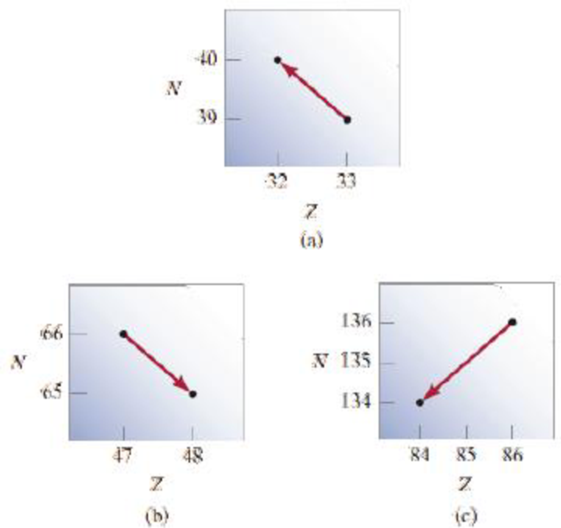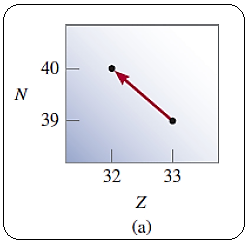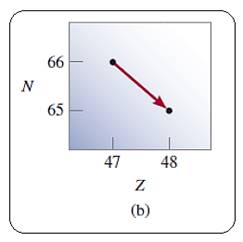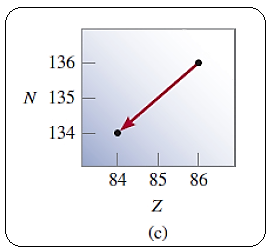
Concept explainers
In each of the diagrams (a)–(c), identify the isotopes involved and the type of decay process. Use the

(a)
Interpretation:
The type of decay and the isotope which undergoes that particular decay should be identified.
Concept Introduction:
Nuclear reaction is a physical process in which there is a change in identity of an atomic nucleus. Natural radioactive decays, artificial radioactive decays... are considered as nuclear reactions because these processes make changes in the identity of an atomic nucleus.
Common particles in radioactive decay and nuclear transformations are mentioned below,
There are various types of nuclear processes. The changes in atomic number and mass number accompanying radioactive decay are mentioned below,
An isotope can be represented using
Explanation of Solution
Given diagram for the decay is,

Figure 1
From the diagram the isotope can be identified,
Atomic number is decreased from
The nuclear reaction can be represented as,
(b)
Interpretation:
The type of decay and the isotope which undergoes that particular decay should be identified.
Concept Introduction:
Nuclear reaction is a physical process in which there is a change in identity of an atomic nucleus. Natural radioactive decays, artificial radioactive decays... are considered as nuclear reactions because these processes make changes in the identity of an atomic nucleus.
Common particles in radioactive decay and nuclear transformations are mentioned below,
There are various types of nuclear processes. The changes in atomic number and mass number accompanying radioactive decay are mentioned below,
Explanation of Solution
Given diagram for the decay is,

Figure 2
From the diagram the isotope can be identified,
Atomic number is increased from
The nuclear reaction can be represented as,
(c)
Interpretation:
The type of decay and the isotope which undergoes that particular decay should be identified.
Concept Introduction:
Nuclear reaction is a physical process in which there is a change in identity of an atomic nucleus. Natural radioactive decays, artificial radioactive decays... are considered as nuclear reactions because these processes make changes in the identity of an atomic nucleus.
Common particles in radioactive decay and nuclear transformations are mentioned below,
There are various types of nuclear processes. The changes in atomic number and mass number accompanying radioactive decay are mentioned below,
Explanation of Solution
Given diagram for the decay is,

Figure : 3
From the diagram the isotope can be identified.
Atomic number is decreased from
The nuclear reaction can be represented as,
Want to see more full solutions like this?
Chapter 19 Solutions
CHEMISTRY 3
- For the following isotopes that have missing information, fill in the missing information to complete the notation (a) X1434 (b) PX36 (c) MX57n (d) X56121arrow_forwardThe following isotopes are important in nuclear power. Write their symbols in the form XZA. a. U-235 b. U-238 c. Pu-239 d. Xe-144arrow_forwardWhat is the nuclide symbol for the nucleus that contains 11 protons and 12 neutrons?arrow_forward
- 2.19 Naturally occurring uranium consists of two isotopes, whose masses and abundances are shown below: Only 235U can be used as fuel in a nuclear reactor, so uramium for use in the nuclear industry must be enriched in this isotope. If a sample of enriched uranium has an atomic weight of 235.684 amu, what percentage of 235LT is present?arrow_forwardWrite the following isotopes in hyphenated form (e.g., carbon-14). (a) N1124a (b) A1329l (c) K3673r (d) I77194rarrow_forwardAn average atomic nucleus has a diameter of about m.arrow_forward
- Though the common isotope of aluminum has a mass number of 27, isotopes of aluminum have been isolated (or prepared in nuclear reactors) with mass numbers of 24, 25, 26, 28, 29, and 30. How many neutrons are present in each of these isotopes? Why are they all considered aluminum atoms, even though they differ greatly in mass? Write the atomic symbol for each isotope.arrow_forwardHow many Ag atoms are present in a piece of pure silver jewelry weighing 21.3 g?arrow_forwardDefine the term atomic weight. Why might the values of atomic weights on a planet elsewhere in the universe be different from those on earth?arrow_forward
- Chemistry: Matter and ChangeChemistryISBN:9780078746376Author:Dinah Zike, Laurel Dingrando, Nicholas Hainen, Cheryl WistromPublisher:Glencoe/McGraw-Hill School Pub Co
 Introductory Chemistry: A FoundationChemistryISBN:9781337399425Author:Steven S. Zumdahl, Donald J. DeCostePublisher:Cengage Learning
Introductory Chemistry: A FoundationChemistryISBN:9781337399425Author:Steven S. Zumdahl, Donald J. DeCostePublisher:Cengage Learning
 Living By Chemistry: First Edition TextbookChemistryISBN:9781559539418Author:Angelica StacyPublisher:MAC HIGHER
Living By Chemistry: First Edition TextbookChemistryISBN:9781559539418Author:Angelica StacyPublisher:MAC HIGHER Chemistry by OpenStax (2015-05-04)ChemistryISBN:9781938168390Author:Klaus Theopold, Richard H Langley, Paul Flowers, William R. Robinson, Mark BlaserPublisher:OpenStax
Chemistry by OpenStax (2015-05-04)ChemistryISBN:9781938168390Author:Klaus Theopold, Richard H Langley, Paul Flowers, William R. Robinson, Mark BlaserPublisher:OpenStax





